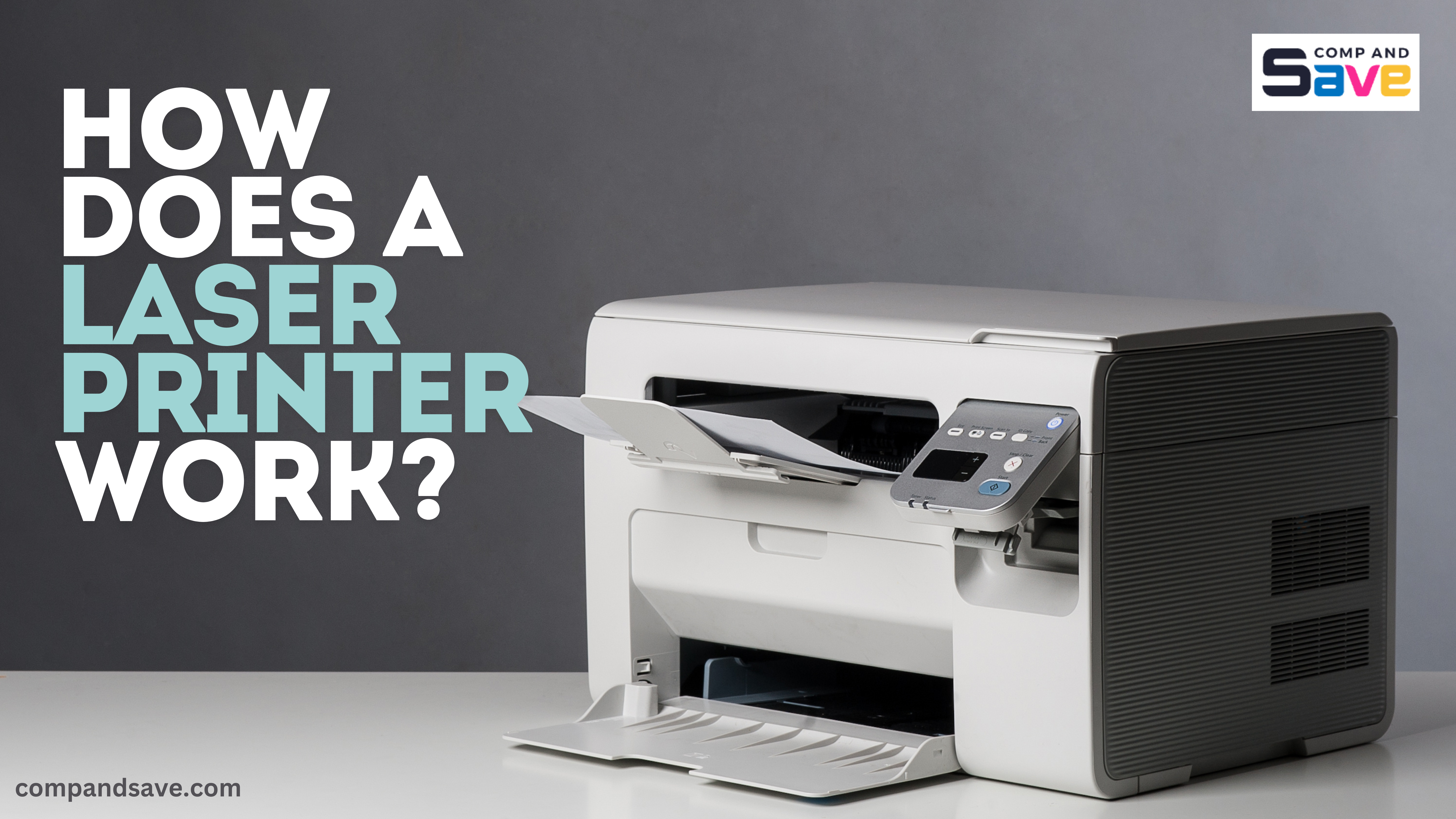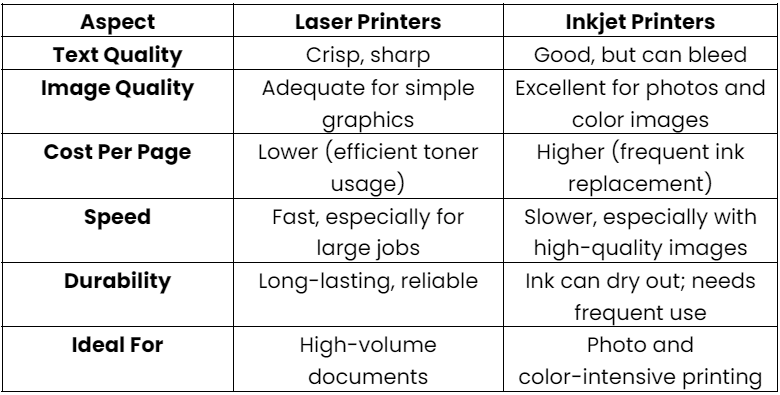How Does a Laser Printer Work: Exploring Laser Technology
| Sep 01, 2024Your trusty inkjet printer whirs to life, but the ink is low, the colors are off, and the pages come out slightly smudged. Frustrating, right? This is where the world of laser printers starts to look a lot more appealing.
Behind every flawless print lies a fascinating process that combines light, static electricity, and precise engineering. Understanding how does a laser printer work not only enhances your appreciation for this technology but also helps you make informed choices when comparing inkjet vs. laser options.
In this article, we’ll cover:
- What is a Laser Printer and its Key Components
- How Does Laser Printing Work: Step-By-Step Process
- Inkjet vs. Laser Printers: The Differences and Applications
- 5 Things To Consider When Buying A Laser Printer
What is a Laser Printer?
A laser printer uses a laser beam to create an image on a drum, then transfer it to paper with a toner (a fine powder). It fuses the toner to the paper with heat and pressure. Laser printers are known for speed and precision and are ideal for high-volume and text-heavy printing. They offer sharp, smudge-free results and are often more cost-effective over time than inkjets.
5 Key Components of a Laser Printer
To fully grasp how does a laser printer work, it’s essential to understand its key components.
- Laser Beam and Diode: The laser beam scans the photoreceptor drum, creating the image. The laser diode generates and focuses the light, ensuring sharp, high-resolution prints.
- Photoreceptor Drum: This cylindrical component holds an electrical charge and interacts with the laser to attract toner. A clean printer drum is essential for clear, streak-free prints.
- Toner Cartridge: This cartridge contains dry powder (toner) in the colors Cyan, Magenta, Yellow, and Black (CMYK). It’s used for high-volume printing and color blending.
- Fuser Assembly: Uses heat and pressure to bond the toner to the paper, making prints durable and smudge-resistant.
- Paper Feed System: This system guides paper through the printer with rollers and sensors to prevent jams and ensure smooth, accurate printing.
How Does Laser Printing Work? Understanding The Mechanism
Ever wondered how laser printers create those sharp, clear prints? It’s all thanks to a high-tech process involving a laser beam and several key components. Let’s explore the mechanism behind laser printing and see why it’s so fast and precise.
Process 1: Data Processing and Sending the Print Job
The first step in how laser printing works is converting digital data from your computer into a format the printer can process. When you hit “Print,” the printer driver translates this data into a language the printer understands. The onboard electronics then prepare the data, ensuring every line, image, and character is accurately reproduced on paper.
Process 2: Charging the Photoreceptor Drum
The next step is charging the photoreceptor drum. A corona wire or primary charge roller applies a uniform positive charge across the drum’s surface. This static charge is essential, allowing the laser to create the image by selectively discharging specific areas on the drum.
Process 3: Drawing the Image with a Laser Beam
In this step, the laser scans across the drum, discharging specific areas to create a pattern of negative charges corresponding to the image or text. The rotating mirror enhances the laser’s precision, enabling high-resolution prints. How do laser printers work? They depend on the laser’s accuracy to draw the image with remarkable detail.
Process 4: Developing the Image with Toner
Once the image is drawn on the drum, it’s time for the toner to do its job. The toner, which is a fine, positively charged powder, adheres to the negatively charged areas on the drum. Components like the toner cartridge, control blade, and developer roller work together to ensure the toner is evenly applied, making this step crucial in understanding how does laser printing work.
Process 5: Transferring the Image to Paper
Once the image is developed on the drum, it is transferred to the paper. As the paper moves through the printer, a positive charge from the transfer roller or belt attracts the negatively charged toner from the drum, transferring the image onto the paper.
Process 6: Fusing the Toner to Paper
Once the toner is on the paper, it must be permanently bonded to prevent smudging. The fuser unit handles this by applying heat and pressure to melt the toner and fuse it into the paper fibers. This process ensures a durable print that won’t fade or smudge, highlighting a key advantage in the inkjet vs. laser comparison.
Process 7: Cleaning and Preparing for the Next Print Job
Finally, the printer cleans up after itself. Any excess toner left on the drum is collected in the waste toner bottle, while electrostatic erase lamps remove any remaining charge on the drum, leaving it ready for the next print job. A clean printer is essential for maintaining print quality and extending the life of your device.
How Does a Laser Printer Work: Advantages of Laser Printers
When choosing a printer, understanding how does a laser printer work can highlight its advantages over inkjets. Laser printers shine primarily in speed, precision, and cost-effectiveness.
1. Speed
How does a laser jet printer work so quickly? A laser beam creates the entire image on the drum in one go, producing up to 50 pages per minute. Laser printers are built for rapid output, unlike inkjet printers, which print line by line.
2. Cost-Effectiveness
How does laser printing work to save you money? Toner cartridges are more efficient than ink, lasting longer and reducing replacement frequency. Finding cheap laser printer toner can maximize these savings. For those seeking the cheapest laser printer, the overall cost-effectiveness of laser printing is a major benefit.
3. Precision
How does a laser printer work to deliver sharp prints? The laser’s precision ensures fine lines and detailed images with no blurring. Maintaining a clean printer for professional documents and marketing materials is essential for top-notch accuracy.
4. Durability
How does laser printing work to ensure durability? Laser printing uses heat and pressure to bond toner to paper, making prints resistant to smudging and fading. This is crucial for long-lasting documents like contracts and reports.
Inkjet vs. Laser Printers: Differences and Best Applications
In the case of inkjet vs. laser printing, each type has its strengths—laser printers are speed demons with sharp text, while inkjets are versatile and excel in color richness.
If you are wondering how inkjet printers work, read this article: How Do Inkjet Printers Work.
5 Things To Consider When Buying A Laser Printer
When deciding on the right laser printer, it’s essential to consider various factors that align with your specific needs. Whether you’re looking for speed, quality, or cost-effectiveness, the following considerations will help guide your decision.
- Monochrome vs. Color Laser Printers: Monochrome printers are fast, cheap, and great for text. Color ones are perfect for vibrant graphics but are pricier and slower.
- Print Speed and Volume Capacity: Look for pages per minute (ppm) if you print a lot. Speeds range from 20 to over 50 ppm. Also, check the monthly duty cycle to avoid printer overload.
- Resolution and Print Quality: Higher DPI means sharper prints. Features like Resolution Enhancement Technology (RET) make text and images smoother.
- Connectivity Options: Wired vs. Wireless: Decide between wired Ethernet for stability or wireless options like Wi-Fi for flexibility. Mobile printing is a bonus for on-the-go printing.
- Paper Handling and Duplexing: For high-volume printing, choose a printer with a large paper tray and auto-duplexing to automatically print on both sides of the paper.
Conclusion
To understand how does a laser printer work, you need to grasp the core process behind its operation. At its heart, a laser printer how does it work involves using a laser beam to scan and create an image on a photoreceptor drum. This drum attracts toner particles, which are then fused to the paper using heat and pressure. This efficient method ensures fast, precise, and high-quality prints.
Whether you’re printing text or graphics, knowing how does laser printing work helps you appreciate its speed and accuracy, making it a standout choice for many printing needs.
Need help? Call CompAndSave at 833-465-6888, Monday through Friday, 6 am to 6 pm PT. We’re here to help!
Frequently Asked Questions
Do laser printers use ink or toner?
Laser printers use toner, a dry powder, rather than liquid ink. Toner is more efficient and better suited for high-volume printing. It provides sharper, more durable prints, ideal for professional-quality documents.
Should I choose a monochrome or color laser printer for my needs?
If you mainly print text-heavy documents, a monochrome laser printer is ideal because it offers faster print speeds and lower costs. However, a color laser printer is the better option if your needs include producing vibrant graphics and color images.
What connectivity options do modern laser printers offer?
Modern laser printers come with various connectivity options, including Ethernet for stability, high-speed wired connections, Wi-Fi for wireless printing from multiple devices, and mobile printing capabilities for easy access from smartphones, tablets, and laptops.
Can a laser printer print on different media types?
Yes, many laser printers are designed to handle various media types, including labels, cardstock, and transparencies. This versatility makes them suitable for different printing tasks in an office or for specialized projects.


